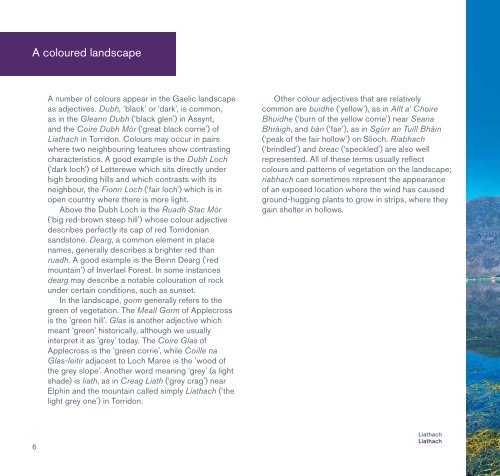Create successful ePaper yourself
Turn your PDF publications into a flip-book with our unique Google optimized e-Paper software.
A coloured <strong>landscape</strong><br />
A number of colours appear <strong>in</strong> <strong>the</strong> Gaelic <strong>landscape</strong><br />
as adjectives. Dubh, ‘black’ or ‘dark’, is common,<br />
as <strong>in</strong> <strong>the</strong> Gleann Dubh (‘black glen’) <strong>in</strong> Assynt,<br />
and <strong>the</strong> Coire Dubh Mòr (‘great black corrie’) of<br />
Liathach <strong>in</strong> Torridon. Colours may occur <strong>in</strong> pairs<br />
where two neighbour<strong>in</strong>g features show contrast<strong>in</strong>g<br />
characteristics. A good example is <strong>the</strong> Dubh Loch<br />
(‘dark loch’) of Letterewe which sits directly under<br />
high brood<strong>in</strong>g hills and which contrasts with its<br />
neighbour, <strong>the</strong> Fionn Loch (‘fair loch’) which is <strong>in</strong><br />
open country where <strong>the</strong>re is more light.<br />
Above <strong>the</strong> Dubh Loch is <strong>the</strong> Ruadh Stac Mòr<br />
(‘big red-brown steep hill’) whose colour adjective<br />
describes perfectly its cap of red Torridonian<br />
sandstone. Dearg, a common element <strong>in</strong> place<br />
names, generally describes a brighter red than<br />
ruadh. A good example is <strong>the</strong> Be<strong>in</strong>n Dearg (‘red<br />
mounta<strong>in</strong>’) of Inverlael Forest. In some <strong>in</strong>stances<br />
dearg may describe a notable colouration of rock<br />
under certa<strong>in</strong> conditions, such as sunset.<br />
In <strong>the</strong> <strong>landscape</strong>, gorm generally refers to <strong>the</strong><br />
green of vegetation. The Meall Gorm of Applecross<br />
is <strong>the</strong> ‘green hill’. Glas is ano<strong>the</strong>r adjective which<br />
meant ‘green’ historically, although we usually<br />
<strong>in</strong>terpret it as ‘grey’ today. The Coire Glas of<br />
Applecross is <strong>the</strong> ‘green corrie’, while Coille na<br />
Glas-leitir adjacent to Loch Maree is <strong>the</strong> ‘wood of<br />
<strong>the</strong> grey slope’. Ano<strong>the</strong>r word mean<strong>in</strong>g ‘grey’ (a light<br />
shade) is liath, as <strong>in</strong> Creag Liath (‘grey crag’) near<br />
Elph<strong>in</strong> and <strong>the</strong> mounta<strong>in</strong> called simply Liathach (‘<strong>the</strong><br />
light grey one’) <strong>in</strong> Torridon.<br />
O<strong>the</strong>r colour adjectives that are relatively<br />
common are buidhe (‘yellow’), as <strong>in</strong> Allt a’ Choire<br />
Bhuidhe (‘burn of <strong>the</strong> yellow corrie’) near Seana<br />
Bhràigh, and bàn (‘fair’), as <strong>in</strong> Sgùrr an Tuill Bhà<strong>in</strong><br />
(‘peak of <strong>the</strong> fair hollow’) on Slioch. Riabhach<br />
(‘br<strong>in</strong>dled’) and breac (‘speckled’) are also well<br />
represented. All of <strong>the</strong>se terms usually reflect<br />
colours and patterns of vegetation on <strong>the</strong> <strong>landscape</strong>;<br />
riabhach can sometimes represent <strong>the</strong> appearance<br />
of an exposed location where <strong>the</strong> w<strong>in</strong>d has caused<br />
ground-hugg<strong>in</strong>g plants to grow <strong>in</strong> strips, where <strong>the</strong>y<br />
ga<strong>in</strong> shelter <strong>in</strong> hollows.<br />
6<br />
Liathach<br />
Liathach


